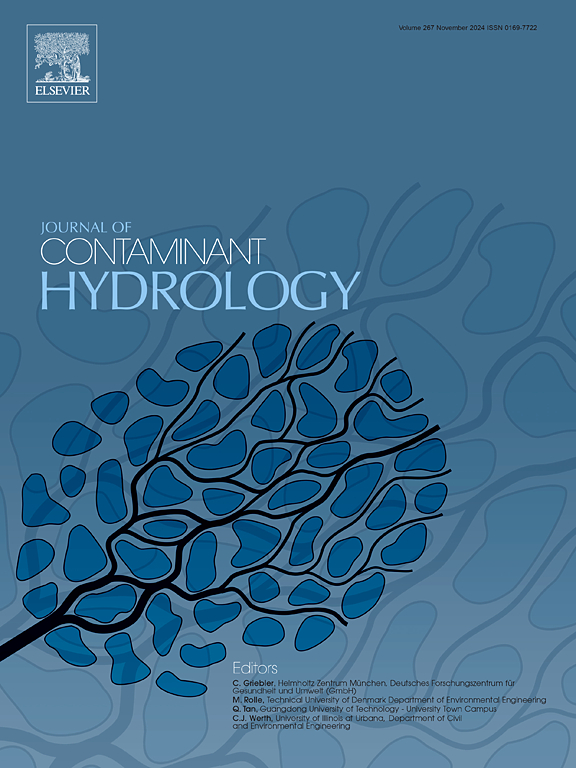人为压力对河流-河口环境微塑料分布的影响:来源分配方法
IF 3.5
3区 环境科学与生态学
Q2 ENVIRONMENTAL SCIENCES
引用次数: 0
摘要
在这项研究中,研究了人为压力,即捕鱼做法和非法和不受管制的废水和固体废物排放,对印度卡拉达河-阿什塔穆迪河-河口环境中微塑料分布的影响。为了更好地表征河口的微塑料污染,将其细分为网箱养殖、露天捕鱼、固体废物倾倒和其他接收居民区废水的区域。采用源分配方法描述了可能的污染源,并进行了暴露于微塑料污染的风险评估。结果表明:固体废弃物倾倒区微塑料丰度最高,网箱养殖区次之;网箱养殖区和露天渔区以纤维状微塑料颗粒为主,固废倾倒区以薄膜状微塑料颗粒为主。FTIR分析显示,网箱渔网和露天渔网以聚酰胺和聚酯为主,固体废弃物倾倒区以聚酰胺、聚苯乙烯和聚乙烯为主。其他受生活污水排放影响的地区显示出大量的聚酯和聚乙烯微塑料。采用结合微塑料形态和化学特征的改进方法进行的来源分配研究表明,渔网/绳索占微塑料污染的35.48%,其次是一次性塑料和塑料袋/覆盖物(各占19.35%),纺织织物(16.13%)和个人护理产品(9.68%)。考虑微塑料丰度和聚合物危害的风险评估分析表明,固体废物倾倒区和网箱养殖区微塑料污染风险为中等。这些发现强调了捕鱼活动和固体废物倾倒对河口环境微塑料污染的作用。本文章由计算机程序翻译,如有差异,请以英文原文为准。
Influence of anthropogenic pressures on the microplastic distribution in the riverine-estuarine environment: A source-apportioning approach
In this study, the influence of anthropogenic pressures, namely fishing practices and illicit and unregulated wastewater and solid waste discharge, on the microplastic distribution in India's Kallada River – Ashtamudi riverine-estuarine environment was investigated. To better characterize microplastic pollution in the Estuary, it was subdivided into cage farming, open fishing, solid waste dumping, and other zones that receive wastewater from residential areas. A source-apportioning approach was utilized to delineate the possible sources of pollution and conducted a risk assessment attributed to exposure to microplastic pollution. The results suggest that the solid waste dumping zone exhibited the highest microplastic abundance, followed by the cage farming zone. Fiber-shaped microplastic particles were abundant in cage farming and open fishing zones, while films dominated the solid waste dumping zone. FTIR analysis revealed that polyamide and polyester, widely used for regional fishing nets, were dominant in cage farming and open fishing zones, while polyamide, polystyrene, and polyethylene were dominant in solid waste dumping zones. Other zones impacted by the unregulated discharge of domestic wastewater exhibited an abundance of polyester and polyethylene microplastics. Source apportionment studies using a modified approach incorporating morphological and chemical characteristics of microplastics revealed that fishing nets/ropes contributed to 35.48 % of microplastic pollution, followed by single-use plastics and plastic bags/covers (19.35 % each), textile fabrics (16.13 %) and personal care products (9.68 %). A risk assessment analysis considering microplastic abundance and polymer hazard revealed that the solid waste dumping zone and the cage farming zone pose a medium risk to microplastic pollution. These findings highlight the role of fishing practices and solid waste dumping on the microplastic pollution in the riverine-estuarine environment.
求助全文
通过发布文献求助,成功后即可免费获取论文全文。
去求助
来源期刊

Journal of contaminant hydrology
环境科学-地球科学综合
CiteScore
6.80
自引率
2.80%
发文量
129
审稿时长
68 days
期刊介绍:
The Journal of Contaminant Hydrology is an international journal publishing scientific articles pertaining to the contamination of subsurface water resources. Emphasis is placed on investigations of the physical, chemical, and biological processes influencing the behavior and fate of organic and inorganic contaminants in the unsaturated (vadose) and saturated (groundwater) zones, as well as at groundwater-surface water interfaces. The ecological impacts of contaminants transported both from and to aquifers are of interest. Articles on contamination of surface water only, without a link to groundwater, are out of the scope. Broad latitude is allowed in identifying contaminants of interest, and include legacy and emerging pollutants, nutrients, nanoparticles, pathogenic microorganisms (e.g., bacteria, viruses, protozoa), microplastics, and various constituents associated with energy production (e.g., methane, carbon dioxide, hydrogen sulfide).
The journal''s scope embraces a wide range of topics including: experimental investigations of contaminant sorption, diffusion, transformation, volatilization and transport in the surface and subsurface; characterization of soil and aquifer properties only as they influence contaminant behavior; development and testing of mathematical models of contaminant behaviour; innovative techniques for restoration of contaminated sites; development of new tools or techniques for monitoring the extent of soil and groundwater contamination; transformation of contaminants in the hyporheic zone; effects of contaminants traversing the hyporheic zone on surface water and groundwater ecosystems; subsurface carbon sequestration and/or turnover; and migration of fluids associated with energy production into groundwater.
 求助内容:
求助内容: 应助结果提醒方式:
应助结果提醒方式:


